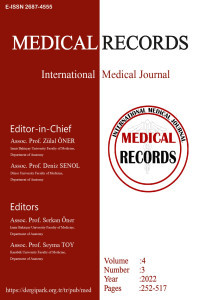The Correlation between Melasma and ABO Blood Type
The Correlation between Melasma and ABO Blood Type
ABO blood types, melasma hyperpigmentation.,
___
- Taraz M, Niknam S, Ehsani AH. Tranexamic acid in treatment of melasma: a comprehensive review of clinical studies. Dermatol Ther. 2017;30:e12465.
- Zhou LL, Baibergenova A. Melasma: systematic review of the systemic treatments. Int J Dermatol. 2017;56:902-8.
- Rajanala S, Maymone MBC, Vashi NA. Melasma pathogenesis: a review of the latest research, pathological findings, and investigational therapies. Dermatol Online J. 2019;25:13030/qt47b7r28c.
- Kwon SH, Park KC. Melasma and common pigmentary dermatoses in Asian individuals and an overview of their treatment. J Clin Investigat Dermatol. 2014;2:8.
- McKesey J, Tovar-Garza A, Pandya AG. Melasma treatment: an evidence-based review. Am J Clin Dermatol. 2020;21:173-225.
- Jiang J, Akinseye O, Tovar-Garza A, Pandya AG. The effect of melasma on self-esteem: a pilot study. Int J Womens Dermatol. 2018;4:38-42.
- Handel AC, Miot LDB, Miot HA. Melasma: a clinical and epidemiological review. An Bras Dermatol. 2014;89:771-82.
- Noh TK, Choi SJ, Chung BY, et al. Inflammatory features of melasma lesions in Asian skin. J Dermatol. 2014;41:788-94.
- Kwon S, Hwang Y, Lee S, Park K. Heterogeneous pathology of melasma and its clinical implications. Int J Mol Sci. 2016;17:824.
- Cooling L. Blood groups in infection and host susceptibility. Clin Microbiol Rev. 2015;28:801-70.
- Stowell CP, Stowell SR. Biologic roles of the ABH and Lewis histo-blood group antigens Part I: infection and immunity. Vox Sang. 2019;114:426-42.
- Göçer Gürok N. The correlation between ABO blood types and acne vulgaris severity. J Cosmet Dermatol. 2023;22:2318-23.
- Ozturk M, An I. Do blood groups play a role in etiology of rosacea? J Cosmet Dermatol. 2020;19:400-3.
- İslamoğlu ZGK, Unal M. Is there an association of ABO blood groups and Rhesus factor with alopecia areata? J Cosmet Dermatol. 2018;17:1271-4.
- Jacoub K, Al-Eisawi Z. ABO blood group and skin cancers. Clin Hemorheol Microcirc. 2022;81:359-71.
- Sehgal VN, Dube B. ABO blood groups and vitiligo. J Med Genet. 1968;5:308-9.
- Olasode OA. Is ABO blood grouping a gene marker for vitiligo? Niger J Med. 2002;11:193.
- Önder S, Etgü FY. Is There an association between blood group types and chronic spontaneous urticaria? Int J Acad Med Pharm. 2021;3:208-11.
- Karadağ A. Comparison of the distribution of blood groups in inflammatory rheumatic diseases and healthy subjects. Cumhuriyet Medical Journal. 2019;41:516-23.
- Zhang BL, He N, Huang YB, et al. ABO blood groups and risk of cancer: a systematic review and meta-analysis. Asian Pac J Cancer Prev. 2014;15:4643-50.
- Behra D, Joshi D. Distribution of ABO blood group and RH (D) factor in Western Rajasthan. J Med Res. 2013;3:73-5.
- Heggelund JE, Varrot A, Imberty A, Krengel U. Histo-blood group antigens as mediators of infections. Curr Opin Struct Biol. 2017;44:190-200.
- Ewald DR, Sumner SC. Blood type biochemistry and human disease. Wiley Interdiscip Rev Syst Biol Med. 2016;8:517-35.
- Neshat S, Rezaei A, Farid A, et al. Cardiovascular diseases risk predictors: ABO blood groups in a different role. Cardiol Rev. 2022;9. doi: 10.1097/CRD.0000000000000463.
- Abegaz SB. Human ABO blood groups and their associations with different diseases. Biomed Res Int. 2021;23:6629060.
- Xie J, Qureshi AA, Li Y, ABO blood group and incidence of skin cancer. PLoS One. 2010;5:e11972.
- Chang L, Pei J, Li C, et al. Incidence and metastasis of cutaneous malignant melanoma with respect to ABO blood groups: a case-controlled study in northeast of China. PLoS One. 2014;9:e88096.
- Altunisik N, Turkmen D, Kayhan Tetik B, Sener S. Evaluation of the relationship between androgenetic alopecia and blood groups and Rhesus factor. Int J Clin Pract. 2021;75:e13647.
- Yayın Aralığı: Yılda 3 Sayı
- Başlangıç: 2019
- Yayıncı: Zülal ÖNER
Role of SARS-CoV2 Virus in the Etiology of Acute Pancreatitis
İlker KIZILOĞLU, Didem DERELİ AKDENİZ, Funda UĞUR KANTAR
The Effect of Mesh Fixation Methods on Pain Sensation After Laparoscopic Inguinal Hernia Repair
The Importance of Perinatal Care Practices in Determining Pregnant Women's Satisfaction with Birth
Ece ÖCAL, Senem ALKAN AKALIN, Serap Mutlu ÖZÇELİK OTCU
Mehmet ÖZER, Pınar Tuğçe ÖZER, Süleyman Cemil OĞLAK, Alper İLERİ, Zübeyde EMİRALİOĞLU ÇAKIR, Barış SEVER, Onur Süleyman ALDEMİR, Sercan KANTARCI, Varol GÜLSEREN, Halil Gürsoy PALA
Prevalence, Number and Localization of Wormian Bones in Anatolian Adult Dry Skulls
Abdullah ORTADEVECİ, Serdar BABACAN
Effect of Folic Acid in Sepsis-induced Lung Damage in Rats
Guner YURTSEVER, Ejder Saylav BORA, Ebru EROĞLU, Yiğit UYANIKGİL, Mümin Alper ERDOĞAN, Oytun ERBAŞ
Nurullah DAMBURACI, Barış SEVİNÇ
Osman KULA, Ahmet Onur ÇELİK, Burak GÜNAY
Effects of Electromagnetic Field (1.8/0.9 GHz) Exposure on Spleen in Rats
İlker KIZILOĞLU, Yeliz YILMAZ BOZOK, Levent TÜMKAYA, Dilek AKAKIN, Dila ŞENER AKÇORA
